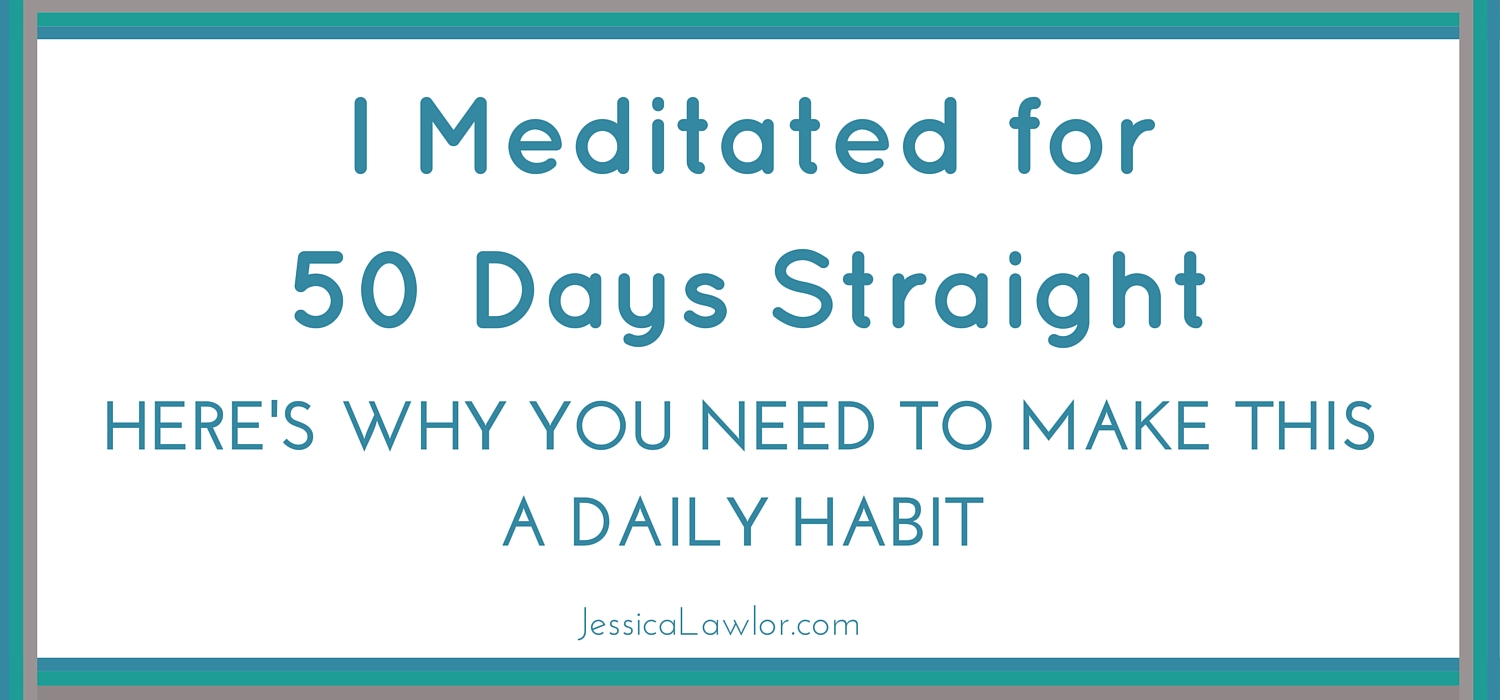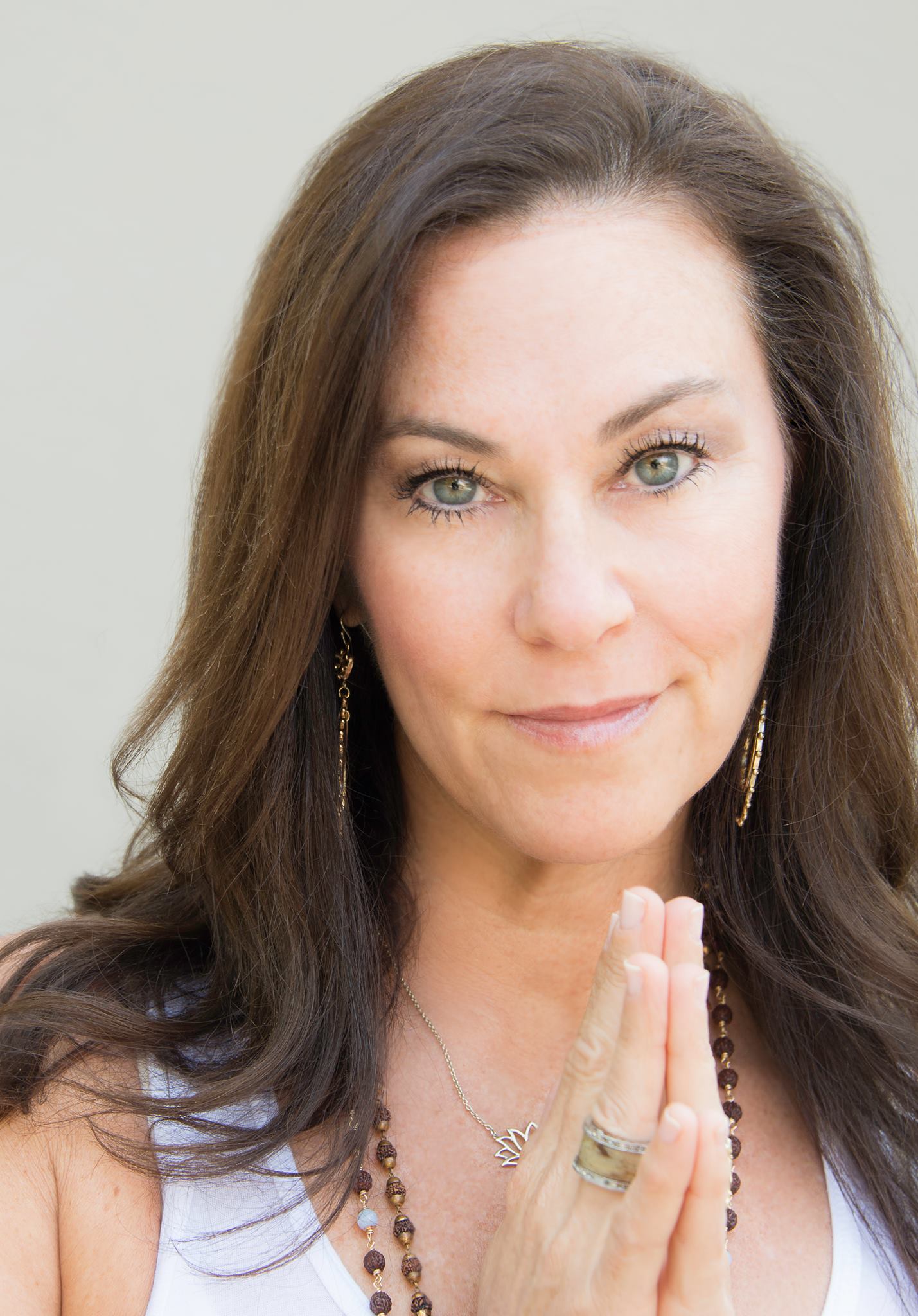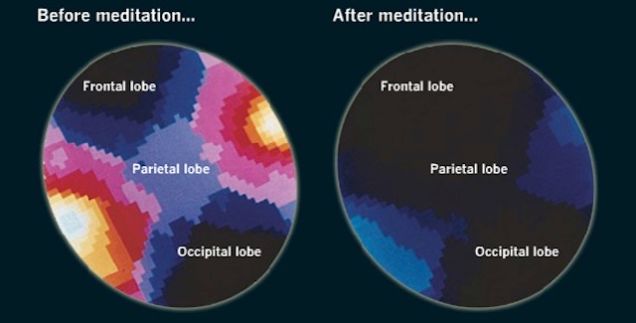
Throughout any given day, we have between 60-80,000 thoughts.
That’s quite a lot happening in our minds.
My thoughts begin the moment I wake up and don’t stop until the day’s end when I shut my eyes and immediately fall asleep, exhausted from the activities of the day. The thoughts are constant…about work, friendships, relationships, food, plans, clothes, travels, logistics, emails, text messages, to-do lists…and so on.
It’s a lot to manage. I’m sure you can relate.
I knew something needed to change. I began to crave stillness. Quiet. Peace.
I needed meditation. More than that, I needed a daily meditation practice.
Meditation is always something I was curious about, but almost immediately dismissed.
Me? Sit quietly each day for 15+ minutes, seemingly waiting for peace to come to me? Uh, no thank you, I don’t have time for that. I can’t be quiet. I can’t be still.
Oh, how wrong I was. With those kinds of thoughts running through my mind, I needed meditation more than I even knew.
Why Meditation?
Meditation is crucial, especially in the fast-paced, ever-changing world we live in. Because of the level of stress we experience on a day-to-day basis, we live in a constant state of fight or flight. Meditation helps us find clarity and stillness.
There are so many mental and physical benefits of meditation. Here are just a few, courtesy of the Chopra Center:
• Relief from stress and anxiety
• Decreased blood pressure and hypertension
• Lower cholesterol levels
• More efficient oxygen use by the body
• Increased production of the anti-aging hormone DHEA
• Restful sleep
Uh, hello?! Don’t you want to be less stressed, look young, get better sleep and have more energy?!
Also, THIS is what happens to our brains when we meditate. Pretty awesome.
How I Found Meditation
As a yoga teacher, meditation is something I learned about in my teacher training. I knew the basics about meditation and various techniques, yet I didn’t have a practice of my own. I never felt confident enough to incorporate meditation into my yoga classes.
In early April, I learned about a Intro To Meditation workshop being held at a local yoga studio. I checked my calendar and when I saw I had a rare completely empty Saturday afternoon, I registered.
Allison Sobel, a meditation expert certified through the Deekpak Chopra Meditation Center, led the workshop. Immediately upon meeting Allison, I felt calm and open to learning. Allison created such a lovely and warm atmosphere.
Throughout the two-hour workshop, we learned so much: the difference between meditation and mindfulness, why we need to meditate, the health benefits of meditation and various meditation techniques and approaches. We spent the last hour of the training actually practicing different meditations, including a visual meditation using a stone, a walking meditation and a mantra meditation.
I walked away from the workshop with the understanding that there are many different ways to meditate and that it was up to me to find the one that serves me best.
My Daily Meditation Practice
Since the workshop with Allison, I’ve committed to a daily meditation practice. Every single day.
Even when I don’t feel like sitting.
Even the morning after a bachelorette party.
Even the morning of a super busy work day.
Every day. No excuses.
For my first few days post-workshop, I used Allison’s free guided meditations available on her website when you sign up for her email list.
I wanted to infuse some variety into my meditation practice, so I downloaded the Calm app.
Holy. Crap. I am obsessed with this app. Calm is the single reason I’ve been able to make daily meditation a reality in my day to day life.
 I love this app for two reasons:
I love this app for two reasons:
1. It offers free and guided meditations that not only give you time for silence and stillness, but also educate. For the past several weeks, I’ve practiced the day’s “Daily Calm”, the app’s featured meditation of the day. Each day tackles a different topic: openness, acceptance, thinking, self-love, patience, concentration, pausing and more. The session starts with the host sharing a few bits of wisdom on the day’s topic and then gives room for reflection and silence. This style resonates with me because it reminds me of the flow of a yoga class with the instructor sharing a quote or theme to help you ground and then allowing you to do your practice. Each meditation lasts around 10-11 minutes, so it’s very manageable.
2. The app tracks your daily progress. You all know I’m very Type A, right? The Calm app’s streak tracker really appeals to my Type A organizational tendencies. I get a little hit of satisfaction when I complete a meditation and see another day added to my streak. The app also tracks your total number of sessions and time spent meditating, which are also fun numbers to be aware of. This type of data drives me and absolutely motivates me to not miss a day.
The Calm app is free, but you can upgrade to a paid plan to gain access to more meditations.
How I Meditate
Meditation is really quite simple. Allison recommends the following steps:
1. Find your position.
2. Become still.
3. Invite the breath.
4. Feel the energy within you.
5. Go inward.
My meditation is that simple, too.
You can meditate any time of day that works for you, but Allison recommends practicing first thing when you wake up- she lives by “RPM”- rise, pee, meditate 🙂
I wake up in the morning, make my bed, pee, brush my teeth and wash my face.
I sit down on my bedroom floor (nothing more fancy than that, people). Sometimes I sit with my legs crossed, other times I sit with my legs extended long. I either place my hands on my knees or thighs or sometimes place my hands on my belly to feel my breath.
I turn on my Calm app, select a meditation for the day and close my eyes. I listen to the guided meditation, embrace the silence and when the meditation ends, I open my eyes and I’m done.
Something super important to note is that not every day is easy. Some days, I definitely think about my to-do list or an email I need to send. Some days I brainstorm blog posts. Some of my meditation practices straight up suck and I peek open my eyes at the time, willing the ten minutes to end.
But the important thing is that I’m turning this into a habit. Each day I do it, it becomes a little bit easier to focus on my breath and let go of my other thoughts. It becomes a little more engrained into my mind and body.
10 minutes is all you need (less, if that’s all you can manage!). Eventually, I plan to increase my meditation time, but for now, I’m reaping the benefits from just 10 minutes of sitting.
What I’ve Noticed Since Starting to Meditate Daily
Many people get frustrated with meditation because they may not immediately experience some kind of outward or noticeable result. I can completely relate. The benefits of meditation aren’t as immediately apparent as practicing yoga, running or changing your diet. The benefits are often more intangible and challenging to notice.
Here are some things I’ve noticed about myself since beginning my daily meditation practice nearly two months ago:
- I start my day on the best note possible. What better way to start your day than by giving yourself the gift of stillness? Now that I meditate first thing, I don’t check my email, scroll through Instagram or watch Snapchat stories right when I wake up. I start my day by taking care of me, not by tending to other people’s priorities.
- Answers come to me. “Silence is loaded with answers.” All those things I worry about on a daily basis? Through silence, my mind seems to work through those problems in a way that my conscious brain can’t.
- I’m more creative. Not only do answers come to me during meditation, so do ideas! Business ideas, blog post ideas, yoga class ideas. My only frustration is that I want to immediately write them down when they come to me, but I try to stay focused on my meditation and jot them down after the fact.
- I feel less anxious. I’ve always struggled a bit with anxiety. Since starting my business, I feel a different kind of anxiety that can sometimes be overpowering. Prior to meditating, I’d feel that anxiety immediately upon waking up and rush out of bed to tackle my to-do list. Now that I force myself to start the day in a slower manner with meditation, my body calms itself down and when I finish my meditation, I feel less anxious.
- Even when I can’t still my mind, my body is still. Listen. Meditation isn’t easy every single day. Some days I want to do anything but sit on my bedroom floor when I feel like I have 1,000 other more important things to do. But on those days I tell myself, even though my mind isn’t still, this is literally the only 10 minutes in my entire day that I will let my body be still.
Five Fast Questions with Meditation Expert Allison Sobel
Curious to learn even more about meditation from a true expert on the subject? I chatted with my teacher Allison Sobel.
1. Why do we need to meditate?

We meditate to enjoy our lives more fully and enhance all the relationships we have. We meditate for better physical and emotional health. We meditate to enhance our creativity.
2. “But I can’t sit still! And I can’t turn my brain off! Meditating is not for me.” How would you respond to someone who told you this?
It’s absolutely okay to have thoughts during your meditation. They are coming and you will not stop them, so don’t even try. They are not interruptions in your meditation; they’re just part of your meditation.
This is an opportunity to process each days activities that otherwise you may not notice or get unprocessed. It’s normal to have thoughts. And when you start a practice it’s your conditioned body-mind letting you know that it’s not used to being still. But be patient and gentle with yourself.
3. If someone told you they literally only have 7-10 minutes a day that they can meditate, how would you recommend they maximize that time?
I personally would recommend a mantra technique as it’s worked best for me for many years.
A Mantra is a Sanskrit word. “Man” means “mind” and “Tra” means “tool or instrument” -an instrument to train the mind. What’s the best approach for them? The best approach/meditation for them is the one that they will do. The one that they can create a daily ritual with. The best technique is the one that works for you!
4. Okay, so I’ve been meditating, but I keep getting distracted with other thoughts. What’s one strategy I can use to bring myself back?
Getting distracted by thoughts is normal. One strategy is to bring the awareness to your breath. Notice the inhale and exhale. Another strategy is to use a rhythmic breathing technique. For example: inhale slowly for a count of four. Hold the breath for 4 counts. Exhale slowly for a count of four. Hold the exhale breath for 4 counts. Repeat this for four rounds and notice how you are feeling.
5. What would you tell a newbie mediator to help them make meditation a daily practice, especially if they are feeling frustrated or like it’s “not working”?
I would tell the newbie that this is a common experience for many people. I would suggest they keep up the practice of meditation because meditation is a gift. A gift you give yourself every time you practice. I would suggest to a newbie to notice how they are the other 23 1/2 hours off their cushion to see the fruits of their practice!
Do you meditate? Have any tips, tricks or favorite apps? Tell me about your meditation practice in the comments below.
Want more gutsy content delivered straight to your inbox twice a month? Be sure to sign up for my FREE #GetGutsy e-newsletter filled with inspiration, ideas and action items to get out of your comfort zone. When you sign up, you’ll also be sent a FREE copy of the Get Gutsy ebook, filled with 19 inspirational stories to help you get gutsy.


